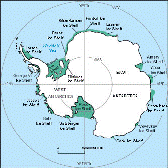Antarctic Drilling Program (ANDRILL)

ANDRILL Related Publications of Affiliates
Document Type
Article
Date of this Version
2007
Abstract
Three sediment gravity cores collected from beneath the McMurdo Ice Shelf and six piston cores from the Erebus Basin (in McMurdo Sound) and the Lewis Basin (north of Ross Island) were analysed in order to construct a retreat history for the West Antarctic Ice Sheet in the Ross embayment since the Last Glacial Maximum. The cores display a characteristic succession of sedimentary facies that record a transition from deposition beneath a marine terminating ice sheet to open-marine conditions. The base of the succession comprises a slightly consolidated, clast-rich muddy diamict dominated by basement clasts from the Transantarctic Mountains, and interpreted as melt-out from the basal debris layer debris proximal to a retreating grounding zone. The diamicts are overlain by sparsely-fossiliferous (reworked diatom frustules) and non-bioturbated mud and fine sands that lack lonestones and are derived from a mostly local source (McMurdo Volcanic Group). This facies is interpreted to have been deposited in a sub-ice shelf setting. Overlying the sub-ice shelf muds are diatom bearing muds and diatomaceous oozes that are indicative of open water conditions, and contain evidence of iceberg rafting. The succession in the open-water Lewis Basin north of Ross Island differs slightly, with the diamict being much sandier and sedimentation rates 1-2 orders of magnitude higher. We also identify a strong relationship between sand provenance and the position of the Ross/McMurdo Ice Shelf calving lines. During periods of glacial advance, regionally grounded ice transports large volumes of sediment derived from the Transantarctic Mountains to the south into Windless Bight, and Erebus and Lewis basins, while during retreat of the grounding line, the sub-ice shelf environment is largely characterized by local sourced terrigenous muddy sedimentation. During open water conditions, hemipelagic sedimentation appears to dominate, with a minor IRD component consisting of sediment with a notable Transantarctic Mountain provenance. Our chronology was developed from twenty three AMS 14C ages, obtained from bulk organic carbon in acid insoluble organic (AIO) material.


Comments
Citation: McKay, R.M., G.B. Dunbar, T. Naish, P.J. Barrett, L. Carter, and M. Harper (2007), A sediment model and retreat history for the Ross Ice (Sheet) Shelf in the Western Ross Sea since the Last Glacial Maximum, in Antarctica: A Keystone in a Changing World – Online Proceedings of the 10th ISAES X, edited by A.K. Cooper and C.R. Raymond et al., USGS Open-File Report 2007-1047, Extended Abstract 159, 4 p.